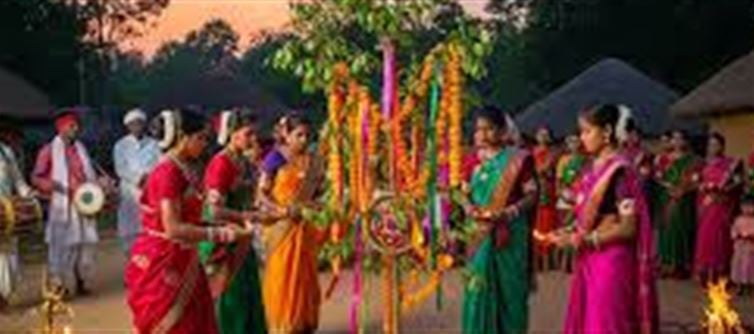
Karma Puja is an ancient and vibrant festival celebrated mainly by the tribal communities in various parts of India, including Madhya Pradesh, Chhattisgarh, Bihar, Jharkhand, and Odisha. This festival, which honors nature and the sacred Karam tree, will be observed on Wednesday, september 3, 2025.
The occasion is not just a celebration but a reflection of the deep-rooted connection between tribal communities and nature. It is a day for prayers for prosperity, family well-being, and long life for loved ones, especially brothers. Here's a closer look at the significance, rituals, and the cultural essence of Karma Puja.
Significance of Karma Puja
Karma Puja is deeply rooted in the reverence for nature and the Karam tree. For tribal communities, nature is not just a resource but is revered as divine. The Karam tree, with its enduring strength and longevity, symbolizes life, growth, and prosperity. Worshipping the Karam branch during the festival is a way of expressing gratitude to nature and asking for blessings for the well-being and longevity of family members, especially brothers.
Symbolism of Karam Tree: The Karam tree, often associated with the festival, stands for fertility, prosperity, and protection. Its worship connects people with the forces of nature, reinforcing the belief that harmony with nature is key to happiness.
Tribal Tradition: Celebrated by the tribal communities in the central and eastern regions of India, Karma Puja highlights the importance of community and togetherness. It reinforces the values of family, community bonding, and respect for the environment.
Rituals of Karma Puja
Karma Puja involves a series of rituals, prayers, and cultural activities that bind the community together. These rituals are designed to seek divine blessings for health, prosperity, and happiness, especially for brothers.
1. The Fast
On Karma Puja, women observe a fast to pray for the long life of their brothers. The fast is an expression of love, care, and a wish for the well-being of the male members of the family. This practice signifies the importance of sisters in the family structure and their role in fostering well-being.
2. Worshipping the Karam Branch
The central ritual of Karma Puja involves the worship of the Karam branch. The Karam branch is ceremonially brought to the village akhara (sacred community space) where it is placed on a platform and decorated with offerings. The branch is adorned with flowers, cloth, and sometimes incense, symbolizing reverence for the sacred tree and its spiritual significance.
3. The Karma-Dharma Story
A key part of the Karma Puja celebrations is the recitation of the Karma-Dharma story. This story, which narrates the lives of two brothers — Karma and Dharma — is an essential part of the ritual. It emphasizes values like duty, honor, and respect for nature. The story is not just an oral tradition but also carries important life lessons about the balance between good deeds and moral responsibility.
The story is believed to instill a sense of balance and responsibility in individuals, reinforcing the connection between moral actions and prosperity.
The story is recited with deep devotion, accompanied by folk songs and dances, which amplify the celebratory atmosphere of the festival.
4. Preparations and Offerings
In the days leading up to Karma Puja, tribal families engage in various preparatory activities:
Cleaning and Decorating: Homes, courtyards, and community spaces (Akhara) are cleaned and decorated to welcome the festival with positive energy.
Traditional Delicacies: During the festival, special foods are prepared, often including sweets and traditional dishes that are shared within the family and community.
Cultural Celebrations: Folk Songs, dance, and Prayers
Karma Puja is not just about rituals; it’s also about community celebrations, folk songs, and traditional dances. The tribal communities come together to celebrate the festival with joy, singing songs and dancing the night away in reverence of nature and the Karam tree.
Folk Songs: These songs tell stories about the Karam tree, the Karma-Dharma tale, and the importance of family and nature. The rhythmic beats of the songs add to the festivity, making it a joyful and energizing celebration.
Traditional Dance: dance forms are an integral part of the festival, as people come together to celebrate nature, family, and community bonds.
Conclusion: A Day of Harmony with Nature
Karma Puja is a vibrant celebration of life, nature, and the bond of love between siblings. The festival provides an opportunity for tribal communities to express their gratitude towards nature and seek blessings for their loved ones. By observing the rituals of Karma Puja, individuals not only honor the Karam tree but also reaffirm their belief in the balance between human life and nature, reinforcing a sense of community harmony and spiritual wellness.
As we celebrate Karma Puja on September 3, 2025, it is a reminder to cherish and protect the natural world, while also fostering love, respect, and care within our families and communities.
.jpg)




 click and follow Indiaherald WhatsApp channel
click and follow Indiaherald WhatsApp channel